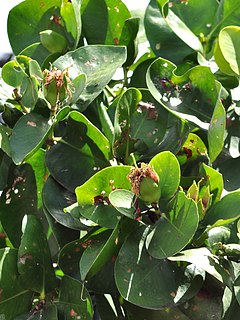Mastixia glauca is a tree in the family Nyssaceae. The specific epithet glauca is from the Greek meaning "bluish-grey", referring to the colour of the leaf underside.
Mastixia macrocarpa is a tree in the family Nyssaceae. The specific epithet macrocarpa is from the Greek meaning "large fruit".
Dysoxylum densiflorum is a tree in the family Meliaceae. The specific epithet densiflorum is from the Latin meaning "dense flowers".
Xanthophyllum ferrugineum is a tree in the family Polygalaceae. The specific epithet ferrugineum is from the Latin meaning "rust-coloured", referring to the inflorescences.
Xanthophyllum montanum is a tree in the family Polygalaceae. The specific epithet montanum is from the Latin meaning "mountainous", referring to the tree's habitat.
Xanthophyllum rufum is a plant in the family Polygalaceae. The specific epithet rufum is from the Latin meaning "reddish", referring to the colour of the twig hairs.
Xanthophyllum schizocarpon is a tree in the family Polygalaceae. The specific epithet schizocarpon is from the Greek meaning "split fruit", referring to the deeply furrowed fruit.
Xanthophyllum trichocladum is a plant in the family Polygalaceae. The specific epithet trichocladum is from the Greek meaning "hairy twig".
Combretocarpus is a monotypic genus of tree in the Anisophylleaceae family. The generic name combretocarpus is from the Greek, referring to the resemblance of its fruit to that of the genus Combretum. As of April 2014 The Plant List recognises the single species Combretocarpus rotundatus.
Canarium divergens is a tree in the family Burseraceae. The specific epithet divergens is from the Latin meaning "diverging", referring to the branching of the inflorescences.
Canarium kinabaluense is a tree in the family Burseraceae. It is named for Mount Kinabalu in East Malaysia's Sabah state.
Dacryodes incurvata is a tree in the family Burseraceae. The specific epithet incurvata is from the Latin meaning "bending inward", referring to the leaflet margin.
Dacryodes longifolia is a tree in the family Burseraceae. The specific epithet longifolia is from the Latin meaning "long leaf".
Mastixia cuspidata is a tree in the family Nyssaceae. The specific epithet cuspidata is from the Latin meaning "sharp-pointed", referring to the leaf apex.
Mastixia eugenioides is a tree in the family Nyssaceae. The specific epithet eugenioides is from the Latin and refers to the resemblance of the leaves to those of the genus Eugenia.
Mastixia pentandra subsp. scortechinii is a subspecies of Mastixia pentandra. It is a tree in the family Nyssaceae. It is named for the botanist Benedetto Scortechini.
Mastixia rostrata subsp. caudatifolia is a subspecies of Mastixia rostrata. It is a tree in the family Nyssaceae. The infraspecific epithet caudatifolia is from the Latin meaning "tapered leaf".

Cratoxylum glaucum is a plant in the family Hypericaceae. The specific epithet glaucum is from the Latin meaning "blue-green", referring to the colour of the leaf underside.

Sonneratia ovata is a mangrove tree in the family Lythraceae. The specific epithet ovata is from the Latin meaning "oval", referring to the shape of the leaf.
Campnosperma squamatum is a tree in the cashew and sumac family Anacardiaceae. The specific epithet squamatum is from the Latin meaning "scaly", referring to the leaf surface.

